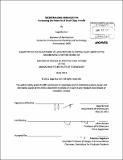| dc.contributor.advisor | Julian Beinart. | en_US |
| dc.contributor.author | Suri, Sagarika | en_US |
| dc.contributor.other | Massachusetts Institute of Technology. Dept. of Architecture. | en_US |
| dc.coverage.spatial | a-ii--- | en_US |
| dc.date.accessioned | 2011-09-13T17:46:47Z | |
| dc.date.available | 2011-09-13T17:46:47Z | |
| dc.date.copyright | 2011 | en_US |
| dc.date.issued | 2011 | en_US |
| dc.identifier.uri | http://hdl.handle.net/1721.1/65747 | |
| dc.description | Thesis (S.M.)--Massachusetts Institute of Technology, Dept. of Architecture, 2011. | en_US |
| dc.description | Cataloged from PDF version of thesis. | en_US |
| dc.description | Includes bibliographical references (p. 113-117). | en_US |
| dc.description.abstract | Perceived as symbols of national development or degeneration, megacities continue to dominate discourse and action related to urbanization, particularly in developing countries like India. Simultaneously, a large portion of urbanized space continues to be described by small and medium sized cities residing in between the rural hinterland and hyper urbanism. These cities are characterized by an intermediate and decentralized form of urbanism, often haphazard and contrasting substantially with their larger counterparts and smaller villages. Because of their size and location, small cities form a vital link within the hierarchy of settlements and are important for the diffusion of development, technology, knowledge and migration between the rural and the urban. Economic liberalization in India has been fostering new social and political mindsets which have translated into policy, governance, investment and concomitantly, urbanization strategies. An important physical manifestation is the spawning of large scale regional and national infrastructure projects-ambitious mega highways, waterways, special investment zones and industrial corridors which transect the hinterland, surround and pass through urban agglomerations and encounter many small cities along the way. Seen as catalysts of transformation befitting an emerging 'superpower', these endeavors are predicted to have contrasting effects ranging from increased connectivity, economic opportunities and growth to loss of quality of life, environmental pollution and social inequality. Regardless of the nature of consequences, small cities are set to be affected in unprecedented ways. The thesis reassesses the potential and future of small cities within this scenario and proposes strategies which utilize the proximity of large infrastructure projects to spawn interventions based on the specific conditions of the city. The historic city of Navsari, Gujarat, located along the western rail corridor and the proposed Delhi Mumbai Industrial corridor (DMIC) has been studied in greater detail to understand the effects of the mega scheme and propose interventions for a sustainable future for the city. | en_US |
| dc.description.statementofresponsibility | by Sagarika Suri. | en_US |
| dc.format.extent | 117 p. | en_US |
| dc.language.iso | eng | en_US |
| dc.publisher | Massachusetts Institute of Technology | en_US |
| dc.rights | M.I.T. theses are protected by
copyright. They may be viewed from this source for any purpose, but
reproduction or distribution in any format is prohibited without written
permission. See provided URL for inquiries about permission. | en_US |
| dc.rights.uri | http://dspace.mit.edu/handle/1721.1/7582 | en_US |
| dc.subject | Architecture. | en_US |
| dc.title | Decentralizing urbanization : harnessing the potential of small cities in India | en_US |
| dc.title.alternative | Harnessing the potential of small cities in India | en_US |
| dc.type | Thesis | en_US |
| dc.description.degree | S.M. | en_US |
| dc.contributor.department | Massachusetts Institute of Technology. Department of Architecture | |
| dc.identifier.oclc | 748974677 | en_US |
